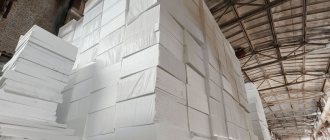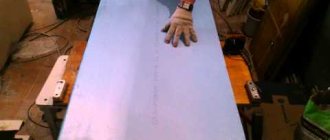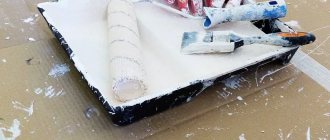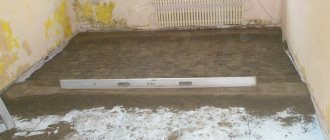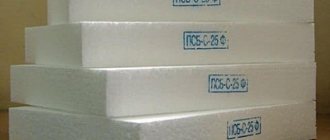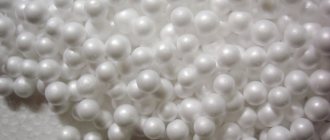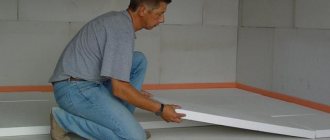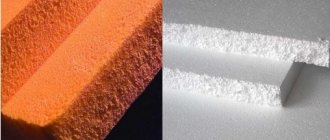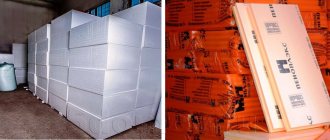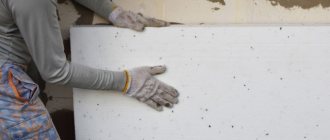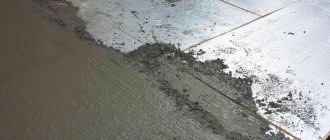Required thickness
In each climate zone, it is important to choose the right thickness of penoplex for insulating walls from the outside, since such positioning allows you to protect the masonry from freezing and extend the service life of wall structures.
A final non-ventilated coating will need to be applied to the front side, which will protect the polymer from the effects of outside air. A final non-ventilated coating will need to be applied to the front side, which will protect the polymer from the effects of outside air.
The value of the thermal resistance of the wall is recommended by SNiPs for each region. In an abbreviated version, the SNiP table 02/23/2003 looks like this:
The specified resistance value is obtained by the sum of the indicators of all materials used, including finishing coatings.
Calculation
As an example, we can take a Moscow wall with a thickness of 1.5 bricks, which will be 0.38 m. The thermal resistance of such masonry is 0.76 m²×°C/W (the thermal conductivity coefficient of brick is 0.5 W/m²×°C, 0 .38:0.5=0.76). The remaining resistance value (3.14-0.76=2.38 m²×°C/W) is provided by insulation and finishing materials. If we multiply the thermal conductivity of penoplex by 0.028 W/m²×°C, we get the required thickness of 6.6 cm. Taking into account external plaster and interior decoration, it is permissible to choose slabs 5 cm thick.
The practice of performing work has shown that when using standard sheets of extruded polystyrene foam, the insulation layer on average is made of the following thickness:
- for internal insulation of premises, slabs with an end face of up to 4 cm are sufficient;
- for external arrangement in a temperate climate, set 5 cm;
- in cold zones 10 cm and conditions of the far north 15 - 20 cm. For more information on calculating the thickness of insulation for walls, see this video:
Before working with this material, we recommend that you familiarize yourself with the technology of wall insulation with penoplex.
Types of penoplex
Penoplex is produced in the form of 5 main varieties, differing in the purpose of the types of work.
- Fundamental. They are mounted on the basement (underground) part of the building and used as permanent formwork. Protect the base of the building from freezing.
- Wall. Needed for external work on thermal and sound insulation.
- "Roof". Installed on attic floors and roof slopes, attic spaces. Blocks heat and sound from rain.
- "Comfort". Designed for interior work (walls, floors, ceilings, balconies).
- Road. The densest grade of this material is labeled “penoplex-45”.
Work on installation on the outer part of the wall is no different in composition from performing internal insulation.
Insulate from inside or outside?
All methods of insulating a building are divided into internal and external. Experts prefer the second method, because in this case, the insulated structures remain under the heat-protective layer. This prevents them from being exposed to negative environmental factors.
Often it is not possible to carry out work on the outside, for example, if the building is of historical value and changing the appearance of its facades is unacceptable. In this case, the method of thermal insulation from the inside is used.
Benefits of internal thermal protection
Compared to external insulation, internal insulation of a house can be done at any time of the year and in any weather conditions.
The facade of the building will not be changed, which is very important if the house was built relatively recently. And finishing the internal surfaces of the walls will cost much less. But despite the obvious advantages of this method, the disadvantages are quite noticeable.
Disadvantages of insulating walls from the inside
The obvious disadvantage of this type of wall decoration is the noticeable reduction in the internal area of the premises.
Such insulation leads to a shift of the “dew point” (the area where steam turns into water) deeper into the insulation layer closer to the inner surface of the walls. Thus, in the cold season, the insulation may become wet and lose its thermal insulation capabilities.
One of the thinnest insulation materials
The benefits of insulation using expanded polystyrene are difficult to overestimate. However, one of the most significant of them is its thickness. This means that the product has practically the lowest thermal conductivity coefficient.
The only material that foam plastic is inferior to is penoizol, which is a multicomponent liquid material. However, it can only be used for insulating non-residential structures.
The reason for this is the high toxicity of the material. In addition, only professional builders can work with foam insulation, but with the help of polystyrene foam, anyone can complete the finishing independently.
Do-it-yourself technology for insulating external walls with polystyrene foam
A craftsman familiar with the basics of finishing work can insulate walls.
Let us consider in detail the insulation method called “wet facade”.
Tools
For work you will need hand and power tools:
- level, plumb line, hammer, tape measure, pencil, hacksaw (knife), trowel and spatula;
- bucket for stirring glue and plaster;
- hammer drill or impact drill with bits or drills for concrete;
- whisk attachments for drills for preparing solutions.
From consumables purchase:
- glue for polystyrene on a cement or synthetic basis;
- dowels with a rod length 4-5 cm greater than the thickness of the foam;
- mounting foam or adhesive foam;
- foam gun.
Work progress step by step
Wall insulation begins with preparatory work:
calculating the amount of insulation and its purchase;
- preparing and checking instruments;
- purchases of consumables;
- installation of scaffolding (if necessary).
The work is carried out in the following sequence:
- The surface of the walls is prepared and cleaned of dust and dirt.
- The voids in the seams (if any) are sealed with cement mortar or foam.
- Level the surface with plaster so that unevenness does not exceed 1.5 - 2 cm. This will make it easier to fit the sheets and reduce the amount of expensive glue during further finishing.
- At a level of 50 cm from the ground, a support bar is attached strictly horizontally, if the foam is not placed to the ground, but finishing is provided with another material.
- Using a level and plumb line, markings are made.
- Apply a sheet according to the markings and through it (to avoid mistakes) drill a hole in the wall for the dowel.
- Starting from the central hole, fix the sheet to the wall.
- The second and subsequent sheets are placed offset (in a checkerboard pattern).
- The seams are sealed with polyurethane foam. Remove excess sealant after complete hardening, usually after 12 hours and up to 24 hours.
- Using a special toothed roller or other available means, punctures up to 0.5 - 1 cm deep are made on the surface of the foam for better adhesion to the layer of adhesive plaster.
- A 1-2 mm layer of specialized polystyrene foam adhesive is applied to the foam plastic, which is leveled with a spatula.
- A fiberglass mesh is applied to the glue and “sunk in.” The joints are overlapped, overlapping by 10 cm. The seams between the sheets and the edges of the mesh should not coincide.
- Level the glue with a spatula. By adding portions of glue in the right places, the final leveling of the surface is carried out, working as if using putty.
Finishing
After the composition has dried, prime the surface with products for external use.
The final finishing is carried out with facade paint or bark beetle plaster. The latter option is preferable, as it hides inaccuracies and irregularities, which are especially visible in side lighting.
There are no tricks when it comes to frame insulation. The foam is secured with wide-headed dowels between the frame slats. The remaining voids are filled with polyurethane foam or adhesive foam. Then, without fail, a waterproofing membrane is nailed to the frame. It is convenient to do this with counter-lattice bars, the thickness of which is 1-1.5 cm. After installing the siding or other material, there will be a gap between it and the foam, which will reduce the likelihood of dampening of the materials - the facade will become “ventilated”.
Foam plastic for wall insulation
Polystyrene foam is an economically advantageous material. Economic benefits manifest themselves not only at the construction stage, but also at the subsequent operation stage. This is achieved due to high heat retention rates for insulating walls and other structural elements, as well as a reliable level of fire resistance.
During installation, slab thickness standards must be observed. For external walls this figure is 50 mm, and for internal walls 30 mm. Density - 25.
Using this material, you can carry out work on external and external insulation of walls. Outside, the installation process takes place using cement mortars, various mounting devices, glue and other things. When installing foam plastic, the inner side will have a good level of noise protection. It is necessary to use plasterboard sheets. You can use an alternative option - plaster.
The plates that are involved in the fastening process for the outer part must meet a thickness of 50 mm. The inner side will require 30 mm. The wall, which is located on the outside of the room, must first be treated with cement mortar. It is applied using a special metal mesh. After completion of the work, we can assume that the foam has been successfully installed.
Density. Index
When working on wall insulation, polystyrene foam has a density index of 25. An external wall with a 50 mm sheet will have high heat retention rates, as well as additional sound insulation.
Polystyrene foam with a density of 25 looks quite advantageous compared to its counterpart, whose density is 15. The main differences are in quality. You can feel a big difference in the quality of foam with a density of 25 and 15 without even starting to use them.
The extruded polystyrene brands presented earlier in the article have the following density indicators:
- 31C (from 28.5 to 30.5 kg).
- 31 (from 28 to 34 kg).
- 45 (from 38.1 to 45 kg).
Vapor permeability properties
The vapor permeability indicator directly affects the efficiency of air exchange that occurs between the inside of the premises and the outside. This happens due to the fact that the air outside has a lower temperature than the inside.
When there is an exchange of air from the inside to the outside, the level of permeability should increase. In terms of vapor permeability, traditional foam plastic is superior to extruded foam.
- Traditional foam has 0.063 mg/(m*h*Pa).
- Extruded foam has 0.013 Mg/(m*h*Pa).
Why is this so? If you use extruded polystyrene foam for external insulation, this will lead to undesirable consequences. Its low vapor permeability has a high level of insulation; this will lead to the accumulation of moisture, which will not allow the materials to dry out and ventilate.
Scheme of application of various brands
The following key types of expanded polystyrene are produced, differing in density and other characteristics:
- PSB-S-15, the density of this brand of foam is up to 15 kg/cu.m.
- PSB-S-25, from 15 kg/cu.m. up to 25 kg/cu.m.
- PSB-S-35, from 25 kg/cu.m. up to 35 kg/cu.m.
- PSB-S-50, from 35 kg/cu.m. up to 50 kg/cu.m.
The thermal conductivity component of foam plastic, expressed in digital values, refers to the range 0.037 W/mK - 0.043 W/mK. The indicated value can be correlated with the thermal conductivity of air, which is equal to 0.027 W/mK.
Use of polystyrene foam PSB-S-15
Polystyrene foam PSB-S-15 can be used for insulation of house facades. This type of insulation is practically not used in construction. It is used in structures that are attached to structures. These can be open balconies or verandas that serve a decorative function. Using PSB-S-15 foam plastic, shapes for facades are formed, and this allows:
- frame the corners of the house, windows;
- separate floors by creating cornices.
What is PSB-S-25 suitable for?
The density of the foam is calculated by analogy with determining the density of brick.
For example, if 1 cube of foam has a density of 25, then its weight will be 25 kg. The flexural and compressive strength of foam depends on its density. The density of polystyrene foam and its brand are completely different characteristics. For example, if we take into consideration SPB-C25 or SPB-C50, the density parameter will fluctuate between 35−50 or 15−25. Plates with a density of 25 are used to insulate the facades of a house. The standard is foam plastic, the thickness of which is 5 cm. This type of insulation is used for many purposes. Its thickness can be changed - this will depend on consumer preferences.
Polystyrene foam of maximum thickness can be used to insulate walls that are exposed to atmospheric agents. They can also be used to insulate walls, since such material perfectly prevents the appearance of fungus.
Based on the designation of the material, it is used in various construction structures, and this does not impair its quality characteristics.
Application of polystyrene foam PSB-S-35
In order to perfectly align the walls, you can change the thickness of the polystyrene foam tiles.
It is not recommended to abuse the size of the thickness of the material, since this will provoke certain problems with fixing the drainage system at the corners of the building. Before choosing insulation of the required thickness, it is recommended to find out in advance how much gas pipe is available, because under no circumstances should it be covered, as this may disrupt the aesthetics of the appearance of the building. In this case, it is advisable to prefer PSB-S-35 material with a thickness of 5 cm over material with a density of 25 and a thickness of 10 cm, especially since their prices are practically the same.
Insulation with a density of 35 can be used to insulate the slopes of windows and doors, and the facades of buildings. As a rule, it costs twice as much as the same polystyrene material with a density of 25. With a thickness of 5 cm, it can be used to insulate non-residential structures and garages. With a thickness of similar insulation of 7 centimeters, it can be used for thermal insulation of residential premises.
Due to the normal level of density, it is possible to use a heat insulator with a minimum thickness, which does not imply a deterioration in the quality of insulation. If the polystyrene foam heat insulator turns out to be harder, then it can be used to provide ideal insulation of basement walls and foundations.
Frame house projects
- 1 room
- 1 bathroom
- 42² Total area
- 6 x 7m Construction area
- 1 room
- 1 bathroom
- 28² Total area
- 5 x 4m Building area
- 4 rooms
- 2 bathrooms
- 170² Total area
- 11 x 8m Construction area
- 3 rooms
- 2 bathrooms
- 127² Total area
- 10 x 7m Construction area
- 4 rooms
- 2 bathrooms
- 200² Total area
- 9 x 13m Construction area
- 4 rooms
- 2 bathrooms
- 140² Total area
- 12 x 9m Construction area
- 3 rooms
- 2 bathrooms
- 127² Total area
- 9 x 8m Construction area
- 4 rooms
- 2 bathrooms
- 130² Total area
- 10 x 10m Construction area
- 3 rooms
- 1 bathroom
- 83² Total area
- 10 x 9m Construction area
- 1 room
- 1 bathroom
- 30² Total area
- 7 x 6m Building area
- 3 rooms
- 2 bathrooms
- 156² Total area
- 11 x 9m Construction area
- 4 rooms
- 2 bathrooms
- 140² Total area
- 8 x 9m Construction area
- 4 rooms
- 2 bathrooms
- 120² Total area
- 8 x 10m Construction area
- 1 room
- 1 bathroom
- 35² Total area
- 5 x 9m Construction area
- 2 rooms
- 1 bathroom
- 42² Total area
- 6 x 9m Construction area
- 2 rooms
- 1 bathroom
- 72² Total area
- 12 x 6m Construction area
- 2 rooms
- 1 bathroom
- 74² Total area
- 7 x 6m Building area
- 3 rooms
- 1 bathroom
- 110² Total area
- 13 x 9m Construction area
- 3 rooms
- 1 bathroom
- 75² Total area
- 9 x 7m Construction area
- 1 room
- 1 bathroom
- 45² Total area
- 6 x 9m Construction area
At a fairly low price, the quality of materials used in frame housing construction is growing every year. It is not surprising that this type of building is becoming increasingly widespread in all regions of Russia. And depending on the climate zone, the same project will have different requirements for heat conservation, therefore, what the thickness of the walls of a frame house should be must be determined in each case separately.
There are several subtypes of frame technology - if the general principle of building houses is the same, then the nuances, including the thickness of the walls, may differ
Insulation technology
Once it has been decided what material is required to complete the work, it is important to familiarize yourself with the nuances of the technology for carrying out the work. When fastening, it is necessary to take into account such thermal insulation features as:
- low strength;
- destruction when exposed to moisture and cold (high-quality waterproofing and vapor barrier will be required);
- instability to fire;
- low vapor permeability, creating a greenhouse effect in the house (a forced ventilation device is required).
The material can be attached from the cold air side or from the inside. Insulation with foam plastic from the outside will be more effective. Insulation of walls with foam plastic from the inside can only be done if there is justification (it is not possible to disassemble the finishing of a house, insulation of one apartment in an apartment building).
We also recommend that you read the instructions for insulating floors with foam. Insulating ceilings with this material also has its own nuances. To ensure reliable protection from the cold, it is better to place the heat insulator on the cold air side.
Fastening to the wall is carried out using glue, and after the solution has dried, the material is additionally fixed with mushroom dowels. It is better to wait about 3 days before you start fixing with dowels. If the thermal engineering calculation was carried out correctly, and the technology was not violated during installation, the foam plastic will be durable and reliable.
We cut carefully
To fill the remaining areas and when insulating protrusions and window openings, it is necessary to cut foam plastic to size. The question is: “How to cut and what to cut with?” does not arise. Trimming can be done with a construction knife, a fine-tooth hacksaw, a mechanical or thermal cutter.
Using knowledge of the characteristics of expanded polystyrene and its dimensions in the calculations, at the end of the work you can find that there is no waste left. Every ruble spent will pay off in reduced heating costs.
Technical characteristics overview
There are different brands of polystyrene foam, each of which has its own set of properties and parameters. Based on this information, a choice should be made.
Thermal conductivity index
Closed cells represent the structure of the foam plastic, due to which this type of insulation acquires the ability to retain heat in the room. The thermal conductivity coefficient is: from 0.033 to 0.037 W/(m*K).
Due to the low thermal conductivity of the insulation, a high degree of energy saving is ensured.
Insulation is considered effective if the value of this parameter is no more than 0.05 W/(m*K). There are more effective materials, however, the average characteristics of polystyrene foam allow it to be successfully used to this day.
Soundproofing qualities, wind protection
The best material for protection against extraneous noise is a material that has the following technical characteristics: low thermal conductivity and at the same time the ability to allow air to pass through. Porous foam fits these criteria. This means that this type of insulation does an excellent job of protecting the object from noise.
Moreover, the greater the thickness of the sheet, the better the soundproofing qualities of the material. If you need to protect an object from the wind, then foam plastic will successfully solve this problem, since it consists of many closed cells.
Moisture absorption
The ability of this type of insulation to absorb water is quite low, which allows it to be considered non-hygroscopic. The moisture absorption rate with constant contact with water throughout the day corresponds to 1%.
The material is indifferent to moisture and practically does not absorb it.
This is slightly more than that of penoplex (0.4%), but also less than that of most of some other analogues, for example, mineral wool. Due to its low hygroscopicity, the service life of the foam is significantly extended, as the risk of mold or mildew formation is reduced.
Temperature
The insulation in question does not change its properties with a significant increase in temperature (up to 90 degrees). Low values also do not have a detrimental effect on this type of material, so it is used, in particular, for thermal insulation of external walls. But during installation using adhesive, it is recommended to observe the temperature regime: not lower than +5 and not more than +30 degrees.
Influence of external factors
These include: temperature changes, wind load, rain, snow and any mechanical source of pressure. The strength of the foam sheet is low under the influence of the last of the factors considered.
Due to its thermal insulation characteristics, polystyrene foam is widely used for insulating walls, roofs, ceilings, and balconies.
This is due to its low weight and large-cell structure. Moreover, the thickness of the material practically does not change the situation. If we compare it with penoplex, this option has high strength characteristics.
Degree of resistance to chemicals and microorganisms
When in contact with a number of substances, the properties of the foam do not change, these include: salt solutions, alkali, acid, gypsum, lime, bitumen, cement mortar, some types of paints and varnishes (silicon-based and water-soluble compositions). It is necessary to avoid contact of polystyrene-based insulation with the following substances: solvents, acetone, turpentine, gasoline, kerosene, fuel oil.
Fire safety
The insulation belongs to highly flammable materials (flammability categories G3 and G4), however, its burning time, provided that the ignition source is eliminated, does not exceed 3 seconds.
If you choose polystyrene foam insulation, be aware that it does not resist fire well.
It would be a misconception to consider such a material completely safe, but it is still often used, due to the release of less energy during combustion, as well as spontaneous attenuation.
Main brands of foam plastic
After foaming the polystyrene, the raw materials for the finished products are loaded into a container. Steam is injected into it under pressure. The granules foam and become saturated with air. At the next stage, the finished granules are dried from moisture; hot air is used for this.
When drying, the granules are shaken periodically. The finished granules are placed in bins that are calibrated according to foam grades. Molding occurs under pressure. When molding, the following types of foam are obtained, which differ in density:
The last number in the marking determines the density of the foam for insulation. Many developers do not know what the specific gravity of foam is. Density (specific gravity) is the mass of a product in its volume. The density of polystyrene grade PSB-S-15 is 15 kg/m³. Accordingly, one cubic meter of PSB-S-15 polystyrene boards weighs 15 kg.
The question arises of how to independently determine the density of foam plastic without special equipment. This is easy to do: you need to calculate the cubic capacity of the finished product and weigh it on the scales. To make a claim, the store must have in hand a state verification certificate of the scales. Weighing can be carried out directly in the store or at the construction warehouse of the materials supplier. This technical calculation of foam density will be the most optimal.
A product with low density has lower compressive strength. It is not able to withstand shock and static loads. The facade can be damaged when removing snow or leaves. Subsequent restoration of the coating and painting work will require additional costs. However, the low density of foam guarantees lower cost with the same thermal insulation properties. The choice of density is based on the scope of application of each brand of product.
PSB-S -15
This grade has the lowest compressive strength at a linear deformation of 10% (not less than 0.04 MPa). The tensile strength of PSB-S-15 foam when bending should not be lower than 0.07 MPa.
PSB-S-15 slabs provide good thermal insulation. Foam plastic, the density of which is not more than 15 kg/m³, has a thermal conductivity of 0.036 W/(m.k). This type of insulation is used to insulate unloaded structures and planes, such as building facades, roofs, ceilings, and gables.
PSB-25
Foam grades with a volumetric weight of 25 kg/m³ are the most popular among private developers. Medium-density slabs combine reasonable prices and good thermal insulation characteristics. This type is versatile and has proven itself well in insulating various structures.
The volumetric weight of foam is in the range of 15-25 kg/m³. The thermal conductivity of polystyrene foam with a volumetric weight of 25 kg/m³ should be less than 0.033 W/(m.k). The linear deformation indicator should not be lower than 0.15 MPa. Bending strength is 0.32 MPa.
PSB-S-35
PSB-S-35 slabs have a fairly wide range of applications. The density of polystyrene foam PSB-S-35 should be in the range of 25-35 kg/m³. This insulation will last up to 40 years. It is less fragile than PSB-S-15 and PSB-S-25. Strength and durability are achieved through closer bonding of styrene molecules.
The thermal conductivity of polystyrene with a volumetric weight of 35 kg/m³ should be less than 0.033 W/(m.k). Bending strength is 0.38 MPa, linear deformation index is 0.26 MPa. This is a hard and durable material.
PSB-S-50
PSB-S-50 is a dense foam that can withstand mechanical and impact loads. It is used for thermal insulation:
- foundations;
- pile foundations;
- floors of industrial enterprises;
- heated roads, parking lots and lots;
- plating of ships and floating craft.
Expanded polystyrene with a density of 45-50 kg/m³ is supplied to order due to low demand and high cost.
The thermal conductivity of such a material should be less than 0.033 W/(mk). The linear deformation indicator approaches 0.38 MPa. Bending strength is 0.42 MPa. This is the densest material.
How long will it last
Foam plastic is resistant to moisture and aggressive substances of organic origin, so the service life before replacement is, according to manufacturers, 700 freeze-defrost cycles.
This is significantly longer than the service life of the plaster layer, in which, in addition to the composition itself, the polymer mesh is destroyed. Based on the recommended operating parameters, you can expect the service life of external foam insulation to be from 20 to 40 years. It all depends on the quality of the building materials and the careful work carried out.
Insulating the walls of a house with polystyrene foam is one of the available ways to save heat in winter and coolness in summer. A simple installation process that anyone can master makes insulation with foamed polystyrene a popular method that allows significant savings on the purchase of materials and wages for builders.
What is extruded polystyrene. Differences between EPP and conventional polystyrene and foam
EPP, polystyrene foam and expanded polystyrene are classified as synthetic polymers. Their production technology ensures high quality characteristics. Polystyrene foam is made from a polymer composition. The resulting granules reach 3-5 mm in diameter. After this, they are pressed using an adhesive composition.
When considering what expanded polystyrene is, it should be taken into account that it is a material that has a uniform structure, including granular cells of no more than 0.1-0.2 mm. To obtain the material, polystyrene granules are mixed with special foaming agents (they can be carbon dioxide or a mixture of freons). After this, sheets are formed under pressure. After drying, they can be used in construction.
Polystyrene foam and polystyrene have much in common with extruded polystyrene foam, but the latter has a more complex production technology. When manufacturing the material, the granules are first melted to a homogeneous mass. After this, special additives and additional components are introduced into the composition, due to which the substance acquires a viscous-fluid state. Thanks to this, a material is obtained that has unbreakable intermolecular bonds.
There are no pores in the finished slabs, and the cells present in this material are filled with gas. Thanks to this structure, the vapor permeability of the material is extremely low. The density of extruded polystyrene foam is much greater than that of polystyrene foam and polystyrene, so it has better performance characteristics.
Advantages and disadvantages
EPS boards have a lot of advantages, but this material also has some disadvantages. The advantages include:
- low thermal conductivity;
- waterproof;
- ability to withstand deformation loads;
- increased rigidity;
- resistance to temperature changes;
- long period of use;
- light weight;
- environmental friendliness.
This insulation is quite rigid, so rodents rarely damage it. At the same time, mice can make moves in the slabs. The water resistance of EPP boards can be a big disadvantage in some cases. When using material to insulate the walls of a wooden house, mold may occur under the formed cake.
Vapor retention near walls can contribute to the appearance of dampness and musty odors. In addition, when heated to temperatures above 75°C, stoves can release substances that can negatively affect human health.
Physical properties of foam plastic
The main characteristics of porous polystyrene include:
- strength – polystyrene foam does not have outstanding strength characteristics and is capable of crumbling and breaking even under weak mechanical stress. It can be easily damaged using sharp objects or simply hitting the surface. To reduce the likelihood of destruction, the foam is covered with layers of harder material that evenly distributes external loads;
- flexibility - expanded polystyrene is weakly susceptible to bending influences and can break under them at any time. For the same reason, foam plastic boards are installed only permanently, avoiding any torsional loads;
- thermal conductivity - the presence of gases (natural heat insulators) in hollow capsules provides the material with a low heat transfer coefficient. This is also facilitated by the lack of convection inside the pores due to their small diameter. It will take a long time to completely heat a piece of polystyrene foam to a given temperature;
- tendency to shrinkage - free-standing polystyrene foam slabs are susceptible to slight shrinkage caused by gravity. The shrinkage amount is 1.5-3 mm over six months. At the end of this period, the natural compaction of the material stops;
- thermal expansion - with increasing temperature, the linear dimensions of the slab increase (the process is reversible). Numerical expansion indicators correspond to approximately 1 mm per 1 m of foam board when the temperature changes by 15-20 ° C;
- vapor absorption - polystyrene foam is less resistant to diffusion penetration of moisture than to the effects of liquid water, therefore in particularly humid rooms its surface is additionally covered with a layer of metal foil. In its absence, some water vapor can penetrate through the layer of material and condense when the temperature drops, which negatively affects the entire thermal insulation system.
We count again
Before purchasing, it is advisable to know: how many people will carry out the installation and at what height, linear dimensions and diagonal dimensions in the room. When insulating the roof, it is necessary to take into account the distance between the rafters. This will allow you to completely determine the required dimensions of the foam sheets.
In some cases, the use of 0.5 by 0.5 m panels is more convenient than slabs of other sizes, even despite the increased consumption of fastening and sealing materials. With larger pieces this can be avoided, but other difficulties arise. Either the size of the room is not enough, or difficulties arise in installation by one person. Therefore, the choice of size must be approached very carefully.
